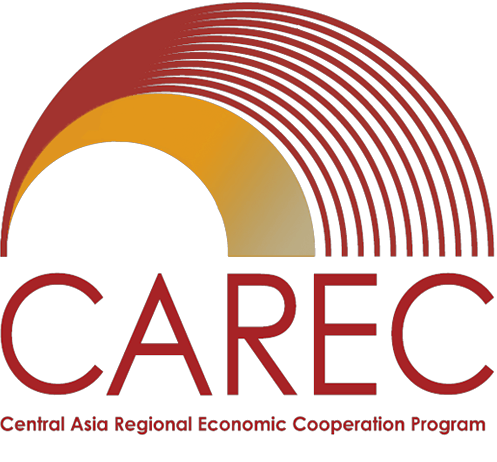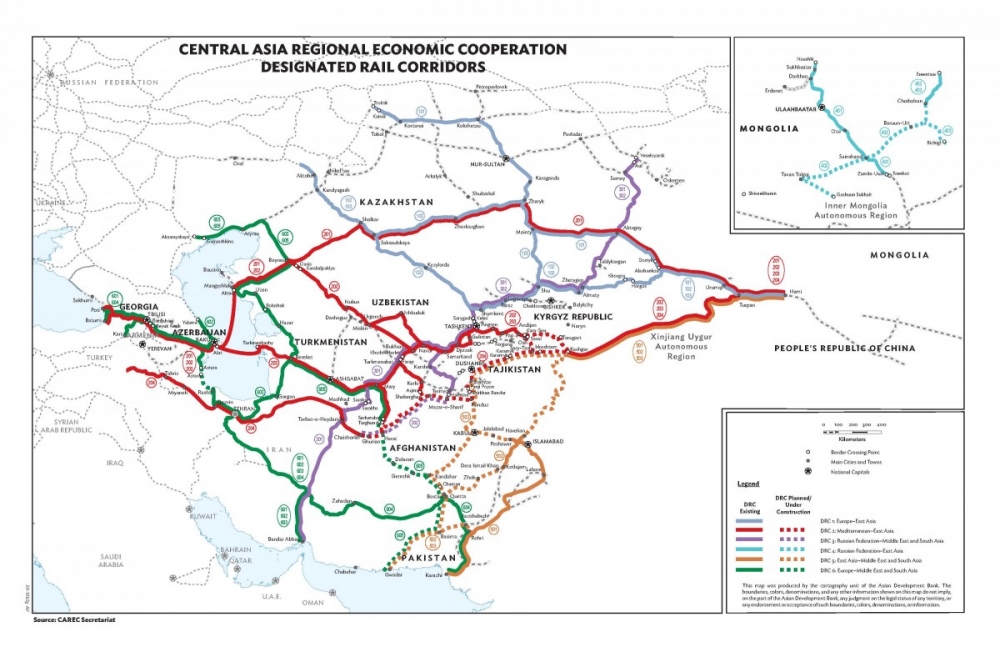Transport
The CAREC region is at the heart of the rapidly growing and integrating Eurasian continent. CAREC countries are working together to improve the region’s transport infrastructure and reduce the cost of trade across regions.
The CAREC Transport Strategy 2030 builds on the progress made and lessons learned from the CAREC Transport and Trade Facilitation Strategy 2020. It is fully aligned with the mission of CAREC Strategy 2030 to enhance regional connectivity for the shared sustainable economic and social development in the CAREC region. This strategy underscores increasing sustainability and quality of transport networks, which alongside with continued construction and rehabilitation of transport corridors, places more emphasis on railway sector development, multimodal interoperability, road asset management, and road safety.
The focus of the strategy builds on the five strategic pillars of roads and road asset management, railways, cross-border transport and logistics, road safety, and aviation as their relevance to the CAREC DMCs has been confirmed; however, it is also open to the inclusion of new strategic transport pillars in response to emerging priorities of the CAREC DMCs and development partners.
The CAREC program will continue to provide a communication and coordination platform for the CAREC DMCs and development partners to present and discuss new projects and transport initiatives. This will enable DMCs to align their priorities with each other and build a well-connected transport network, regulations, and operational practices. The strategy will support the CAREC sustainability agenda by addressing the strong demand to convert transport infrastructure investments into sustainable economic and social development for the region.The CAREC Transport Strategy 2030 was endorsed by the CAREC Ministers in November 2019.
View 2021-2022 Country Highlights
View Transport Sector Progress Report and Work Plan (July 2023–June 2024): English | РУССКИЙ
View Transport Sector Progress Report and Work Plan (July 2022–June 2023): English | РУССКИЙ
View Transport Sector Progress Report and Work Plan (July 2021–August 2022): English | РУССКИЙ
View Transport Sector Progress Report and Work Plan (July 2020–August 2021): English | РУССКИЙ
View Transport Sector Progress Report and Work Plan (July 2019–August 2020): English | РУССКИЙ
CAREC Road Safety Strategy
Safely Connected: A Regional Road Safety Strategy for CAREC Countries (2017-2030) provides the framework to make CAREC corridors safe, efficient, and attractive for all road users. The strategy resulted from intensive consultation between country representatives, road safety experts, private sector stakeholders, and development partners.
Vision: To make CAREC international road corridors safe, efficient and attractive for all road users.
Target: To reduce the number of fatalities on the CAREC road corridors by 50% by 2030 (compared to 2010), or saving an estimated 23,000 lives and 250,000 serious injuries less per year. The estimated economic savings amounts to approximately $16 billion a year.
Implementation: (i) embed road safety features to planned investments for road projects amounting to about $6.9 billion from 2017 to 2020; (ii) provide technical support for national road safety policy initiatives, and (iii) technical support for institutional strengthening and capacity development.
Learn more about CAREC Road Safety
CAREC Railway Strategy
Unlocking the Potential for Railways: A Railway Strategy for CAREC (2017-2030) serves as a guiding document for the long-term development of CAREC railways. The strategy was jointly developed by CAREC country representatives in cooperation with development partners, railway operators, stakeholders and experts. The strategy equips the region’s railways to better capture evolving trade flows and contribute to regional economic development.
Vision: Rail transport will become a mode of choice for trade: quick, efficient, accessible for customers, and easy to use throughout the region.
Strategic Priorities: (i) develop effective rail infrastructure ; (ii) develop robust commercial capabilities; and (iii) improve legal and regulatory frameworks.
Implementation: Full implementation of the railway strategy requires a set of robust arrangements addressing money (financing), people (capacity), and technology with distinct roles identified for (i) railways, (ii) governments and (iii) development partners. An action plan and corresponding results-based framework is being developed and will be subject to periodic monitoring, review, and adjustments
Learn more about CAREC Railways
Key Projects
As of December 2023, nearly $34.45 billion (67.5% of the total CAREC Project Investments) has been invested along the six CAREC transport corridor routes, where the potential for economic development and returns is greatest. Priority infrastructure work along the six corridors is now focused on the construction and upgrade of roads and rail lines.
Pakistan: Faisalabad-Multan (M4) Road Project
Afghanistan: Hairatan to Mazar-e-Sharif Railway Project
Creating CAREC Corridors
CAREC focuses investment and other activities on the development of six competitive transport corridors that link north, south, east, and west through the pivot of Central Asia. The corridors reflect trade flow patterns and will speed the movement of people and goods across the region. Critically, they also connect the mainly landlocked CAREC countries to wider regional and global networks.
CAREC Priority Investment Projects by Corridor
Corridor 1 | Corridor 2 | Corridor 3 | Corridor 4 | Corridor 5 | Corridor 6
Learn more about CAREC Transport Corridors
Transport Sector Coordinating Committee
The Transport Sector Coordinating Committee (TSCC) guides strategic decision making and planning for all transport-related investments. It also coordinates other sector-wide issues and activities, including
- events and capacity-building activities,
- identifying transport sector pilot projects and development issues with sector-wide implications, and
- coordinating the work of transport project working groups.
The TSCC regularly reports and makes recommendations to the CAREC Senior Officials’ Meeting, which in turn informs the CAREC Ministerial Conference. It meets at least once a year and the host country for each committee meeting acts as the official chair of that meeting.
(Refer to the CAREC institutional framework for more information on sector coordinating committees.)
Partnerships
CAREC development partners in the transport sector share responsibility in providing directions and drawing up priority actions. This section provides a communication platform for development partners to present projects and transport initiatives as well as features works and achievements of development partners in the CAREC Transport program.

